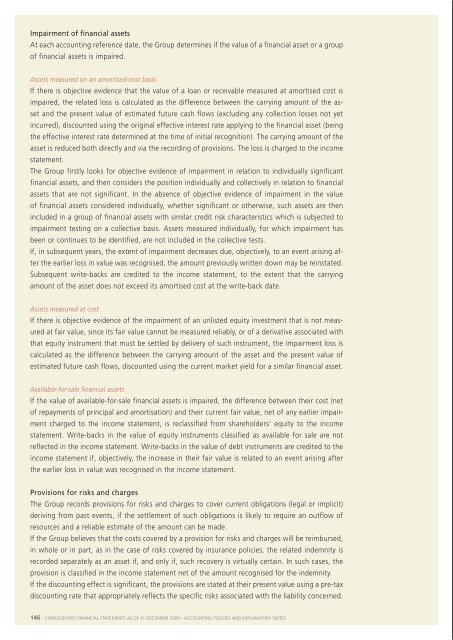Financial Statements 2009 - Manutencoop
Financial Statements 2009 - Manutencoop
Financial Statements 2009 - Manutencoop
You also want an ePaper? Increase the reach of your titles
YUMPU automatically turns print PDFs into web optimized ePapers that Google loves.
Impairment of financial assetsAt each accounting reference date, the Group determines if the value of a financial asset or a groupof financial assets is impaired.Assets measured on an amortised-cost basisIf there is objective evidence that the value of a loan or receivable measured at amortised cost isimpaired, the related loss is calculated as the difference between the carrying amount of the assetand the present value of estimated future cash flows (excluding any collection losses not yetincurred), discounted using the original effective interest rate applying to the financial asset (beingthe effective interest rate determined at the time of initial recognition). The carrying amount of theasset is reduced both directly and via the recording of provisions. The loss is charged to the incomestatement.The Group firstly looks for objective evidence of impairment in relation to individually significantfinancial assets, and then considers the position individually and collectively in relation to financialassets that are not significant. In the absence of objective evidence of impairment in the valueof financial assets considered individually, whether significant or otherwise, such assets are thenincluded in a group of financial assets with similar credit risk characteristics which is subjected toimpairment testing on a collective basis. Assets measured individually, for which impairment hasbeen or continues to be identified, are not included in the collective tests.If, in subsequent years, the extent of impairment decreases due, objectively, to an event arising afterthe earlier loss in value was recognised, the amount previously written down may be reinstated.Subsequent write-backs are credited to the income statement, to the extent that the carryingamount of the asset does not exceed its amortised cost at the write-back date.Assets measured at costIf there is objective evidence of the impairment of an unlisted equity investment that is not measuredat fair value, since its fair value cannot be measured reliably, or of a derivative associated withthat equity instrument that must be settled by delivery of such instrument, the impairment loss iscalculated as the difference between the carrying amount of the asset and the present value ofestimated future cash flows, discounted using the current market yield for a similar financial asset.Available-for-sale financial assetsIf the value of available-for-sale financial assets is impaired, the difference between their cost (netof repayments of principal and amortisation) and their current fair value, net of any earlier impairmentcharged to the income statement, is reclassified from shareholders’ equity to the incomestatement. Write-backs in the value of equity instruments classified as available for sale are notreflected in the income statement. Write-backs in the value of debt instruments are credited to theincome statement if, objectively, the increase in their fair value is related to an event arising afterthe earlier loss in value was recognised in the income statement.Provisions for risks and chargesThe Group records provisions for risks and charges to cover current obligations (legal or implicit)deriving from past events, if the settlement of such obligations is likely to require an outflow ofresources and a reliable estimate of the amount can be made.If the Group believes that the costs covered by a provision for risks and charges will be reimbursed,in whole or in part, as in the case of risks covered by insurance policies, the related indemnity isrecorded separately as an asset if, and only if, such recovery is virtually certain. In such cases, theprovision is classified in the income statement net of the amount recognised for the indemnity.If the discounting effect is significant, the provisions are stated at their present value using a pre-taxdiscounting rate that appropriately reflects the specific risks associated with the liability concerned.When provisions are discounted, the subsequent increases due to the passage of time are recordedas financial charges.Provision for benefits due on the termination of employmentA liability for benefits due on the termination of employment is recorded when, and only when, theGroup is demonstrably committed to: (a) terminating the employment of an employee or a group ofemployees before the normal retirement date; or (b) paying benefits for the termination of employmentfollowing the offer of voluntary redundancy incentives. The Group is demonstrably committedto terminating employment when, and only when, it has a detailed formal plan for such terminationand there is no realistic likelihood that this plan will be withdrawn.Employee benefitsItalian legislation (art. 2120 of the Italian Civil Code) envisages that, upon termination of employment,each employee shall receive a severance indemnity (TFR). The calculation of this indemnityis based on certain items comprising the employees’ annual remuneration for each year of work(suitably revalued) and on their length of service. Pursuant to Italian legislation, this indemnity isreported in the financial statements using calculations based on the amount that would be dueto each employee at the reporting date, assuming that their employment terminated at that time.The International <strong>Financial</strong> Reporting Interpretations Committee (IFRIC) of the International AccountingStandards Board (IASB) has examined the subject of Italian TFR and concluded, pursuantto IAS 19, that it represents a “defined benefit” plan in the context of post-employment benefits.As such, the provision must be calculated using the Projected Unit Credit Method (PUCM), wherebythe liability for benefits earned must reflect the expected termination date and must be discountedto present value.Following the 2007 reform of the relevant Italian regulations governing the TFR accrued subsequentto 1 January 2007 by companies with more than 50 employees, the provision now represents a“defined contributions” plan and payments are charged directly to the income statement as a costwhen incurred. The TFR accrued up until 31.12.2006 continues to represent a defined benefits plan,to which no further contributions are made. Accordingly, the provision is now determined by independentactuaries with sole reference to the average expected residual working lives of employees,without considering the remuneration earned by them over a predetermined period of service.The calculations for the TFR “accrued” prior to 1 January 2007 have therefore changed, due to exclusionof the actuarial assumptions about wage and salary increases that were required previously.In particular, the provision for “accrued TFR” was determined on an actuarial basis as of 1 January2007 without applying the pro-rata (years of service worked/total expected length of service),since the employee benefits accumulated up to 31 December 2006 can be considered to have beenalmost entirely earned (except for the annual revaluation) pursuant to para. 67 (b) of IAS 19. It follows,for the purposes of this calculation, that there are no current service costs relating to futureservices from employees, since these are represented by the contributions paid to supplementarypension funds or to the INPS Treasury Fund.In addition, commencing from 2008, the Group has decided to modify the accounting policy applyingto the TFR accrued up to 31 December 2006. As a consequence, the Group has recorded theactuarial gains (or losses) deriving from application of the projected unit credit method in a specificequity reserve pursuant to paras. 93B and 93D of IAS 19.The actuarial gains and losses on defined benefit plans accumulated up to the prior year have beenreclassified to an equity reserve. These amounts reflected the effects of changes in the actuarialassumptions used and, up to 31 December 2007, were recognised in full in the income statement.Accordingly, the so-called “corridor method” has not been applied. This method allocates actuarial146 - Consolidated financial statements as of 31 December <strong>2009</strong> - Accounting policies and explanatory notes Consolidated financial statements as of 31 December <strong>2009</strong> - Accounting policies and explanatory notes - 147








